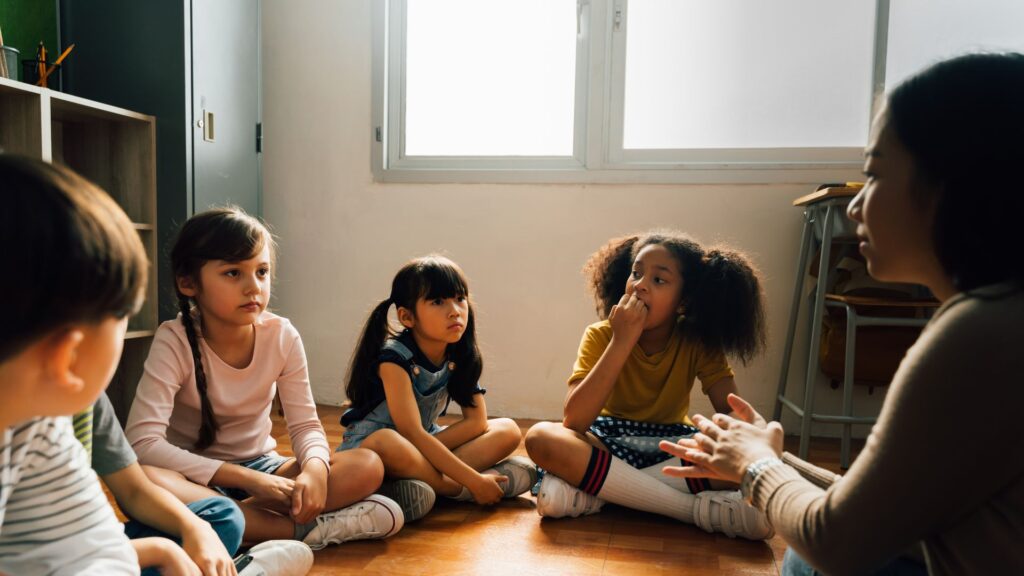Content warning: This post discusses self-harm and suicide.
Self-harm remains a misunderstood and misrepresented topic, even among mental health professionals. Although we’re not technically in Self-Harm Awareness Month (March) anymore, we’d like to continue the conversation and offer resources.
In this blog, we’ll cover key takeaways from the Pacific Southwest Mental Health Technology Transfer Center Network’s (MHTTC) webinar for school professionals titled “Self-Harm, Suicide Awareness, and Prevention in Childhood and Early Adolescence.”
Their presentation includes resources to help recognize, assess, and respond to the warning signs of suicidal thoughts and behaviors (STBs) so that more children are kept safe.
Important terms and phrases when talking about suicide risk
Presenters Dr. Meagan O’Malley, Frances Marion LCSW, and Jessica Palacio LCSW opened the webinar by saying they’ll use the phrase suicidal thoughts and behaviors (STBs) to encompass all of the following terms:
- Suicidal ideation: Thinking about, considering, or planning death by suicide.
- Suicide attempt: An act with the intent to die that does not result in death. A suicide attempt may or may not result in injury.
- Non-suicidal self-injury/self-harm: Injuries inflicted to the body without suicidal intent (e.g. cutting, scratching, burning self, pulling one’s hair out, hitting self).
They also use the phrase “death by suicide” instead of “committed suicide” to communicate a neutral, non-judgemental stance. Phrases like “committed suicide” or “completed suicide” may reinforce stigma and misunderstandings associated with suicide (such as suicide being a sin/crime or suicide being an achievement).
Understanding of the risk factors and warning signs of suicide in children
Risk factors are often an indicator that a child needs attention and support while warning signs show that someone might be considering suicide right now.
Here are some risk factors to keep in mind:
- Trauma, including emotional, physical, and/or sexual abuse, neglect, or domestic violence
- Peer-related problems, including experiencing bullying or bullying others
- Familial rejection, including due to sexual orientation or gender identity
- Personal or family history of mental health conditions or suicide
- Recent loss or separation
- Access to lethal means such as a firearm
Common warning signs in young children include:
- Dramatic changes in mood or behavior, including impulsive or risky behaviors
- Unexplained drops in academic performance
- Fatigue, anger, irritability, sadness, loss of interest, or other symptoms of depression
- Talking, writing/drawing, or pretend play with themes of death
- Making statements like “I wish I could disappear” or “I hate my life”
- Frequent visits to the school nurse with vague physical complaints, such as stomachaches and headaches
- Making final arrangements or posting goodbye posts on social media
As a reminder, self-injury might include behaviors like scratching oneself with fingernails or objects, cutting or burning skin, hitting oneself, picking at skin or nails causing bleeding, and pulling one’s hair.
Look out for these warning signs of self-injury:
- Unexplained cuts, bruises, or burns
- Wearing long sleeves or bracelets to cover marks
- Avoiding activities that require less clothing, such as swimming
- Finding razors or other sharp object
- Writing or talking about self-injury, including posting about it on social media
Protective factors against suicide and school-based approaches to prevention and intervention
Protective factors are elements that promote health and well-being while also reducing or mitigating risk factors.
Here are some crucial protective factors:
- A sense of belonging; being able to talk to trusted adults about their problems
- Experiencing success academically and/or in extracurricular activities
- The ability to identify feelings, use coping skills, and solve social problems
- Safe, stable living environments and strong familial support
- A positive sense of identity, including healthy racial socialization, LGBTQ+ affirming
- For Native youth, a connection to tribal culture and spirituality
Phases of suicide response for school professionals
In this section, Dr. Meagan O’Malley emphasized that school-based clinicians play an important role in building and sustaining systems for predictable STB response. Establishing a reliable system helps educators feel more confident that there will be appropriate interventions if they identify warning signs of STBs in their students.
What’s not pictured here is a more general preparedness that needs to happen so that you’re ready to respond when an educator comes to you seeking guidance.
A few ways you can prepare include:
- Familiarizing yourself with relevant laws and policies associated with your state/region about what’s expected of school-based practitioners for response
- Identifying and training a group of staff who can conduct risk assessments
- Being ready to help children understand the limits of confidentiality in the context of risk assessment
- Being comfortable asking a child directly if they’re thinking of hurting themselves or killing themselves (use calm, matter-of-fact language and communicate nonjudgmental curiosity)
- Emphasizing that the student isn’t in any trouble
- Incorporating tools and techniques for helping young people communicate (rephrasing directions, having play-based conversations, etc.)
Strategies to communicate with parents and caregivers of children at risk for suicide
When reaching out to parents or caregivers, it helps to speak from a place of empathy and compassion. Some caregivers might feel nervous or ashamed about having these conversations, and your approach can ease those worries.
Take these steps when communicating with caregivers:
- Notify parents/caregivers of any warning signs of suicidal ideation or self-injurious behaviors
- Emphasize that neither they nor their child are in trouble and reiterate your desire to support the family
- Gather additional relevant information from caregivers to understand risk level
- Connect families to community resources, such as medical and mental health care providers
Learn more about self-harm and suicide prevention for school professionals
This presentation is part of a more in-depth resource for educators and school-based professionals. You can check out the full guide here!
Subscribe to the South Southwest MHTTC newsletter to stay up-to-date with the latest resources, news, and research for mental health professionals.

